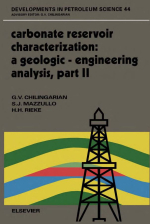Добрый день, Коллеги. Важное сообщение, просьба принять участие. Музей Ферсмана ищет помощь для реставрационных работ в помещении. Подробности по ссылке
Carbonate reservoir characterization: a geologic - engineering analysis, part II / Характеристика карбонатного коллектора: инженерно-геологический анализ, часть II
The approach in Part 2 of this book builds on the various geoscience and engineering methodologies and technologies presented in the first volume. Part 1 presented fundamentals of geologic and engineering concepts for characterizing and evaluating carbonate reservoirs using a wide range of scales. Carbonate rocks are not homogeneous or isotropic in their properties. Hence, porosity, fluid saturation, bed thickness, and carbonate rock types show very little uniformity throughout reservoirs. Permeability, in most cases, also is strongly anisotropic in carbonate reservoirs. Detailed reviews of the classification, depositional models, and diagenesis of carbonate rocks in Part 1 exposed the reader to a wide range of viewpoints on these subjects. Correlations among permeability, porosity, irreducible fluid saturation, specific surface area, and capillary pressure were established, and used to characterize the static nature of fluid in carbonate reservoirs. Fluid flow dynamics in oil and gas reservoirs were reviewed. Presentation of the volumetric, material balance, and performance decline methods for oil and gas reserve estimation focused on the business side of analyzing production from carbonate reservoirs. The application of computer modeling was shown to be effective in characterizing carbonate reservoirs. Practical application of acid stimulation techniques used to increase the productivity of wells in carbonate reservoirs was discussed in the final chapter of Part 1.
Part 2 concentrates on state-of-the-art technologies and practices used to obtain basic information on carbonate reservoirs. There are many challenges in properly characterizing a carbonate reservoir, such as reservoir classification schemes, incremental recovery strategies, and carbonate reservoir heterogeneity. These issues are discussed in Chapter 5. Figure 1-1 is an interactive flow diagram that presents a scheme of contemporary reservoir evaluation. Worthington (1991) pointed out that the integration of the data obtained by using downhole measurements and core analysis into a physically equivalent, unified reservoir model is a process of reservoir characterization. Such technical efforts in reservoir analysis can have only beneficial results in defining the influence of heterogeneities on fluid flow in carbonate reservoirs. Closely-spaced drilling, extensive and specialized coring, advanced well logging tools, tracer tests, digital production, and pressure monitoring provide detailed information needed to perform such analyses. Weber (1986) suggested that another reason for the improved capacity to decipher the influence ofheterogeneities on reservoirs is our ability to simulate fluid flow using advanced reservoir models with the aid of supercomputers. Both static and dynamic reservoir models are linked through reservoir characterization. In order for the link to be effective, a proper understanding of fluid flow constraints in the carbonate reservoir rocks is necessary for predicting and evaluating primary, secondary, and tertiary recovery operations. Enhancement of reservoir productivity is the goal, but it has its price. <...>




